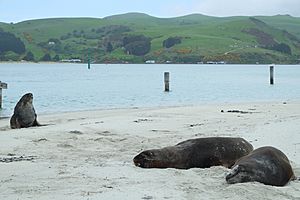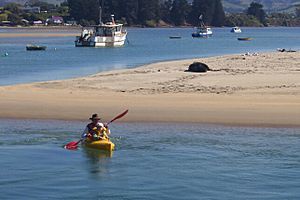New Zealand sea lion facts for kids
Quick facts for kids New Zealand sea lion |
|
|---|---|
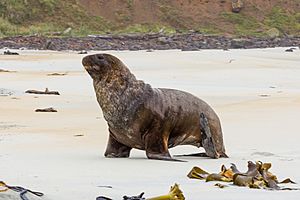 |
|
| Male | |
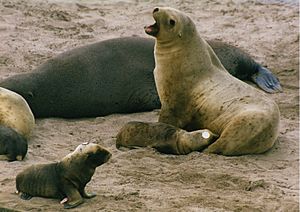 |
|
| Female with pup | |
| Conservation status | |
| Scientific classification | |
| Genus: |
Phocarctos
|
| Species: |
hookeri
|
 |
|
| New Zealand sea lion range | |
The New Zealand sea lion (Phocarctos hookeri) is also known as Hooker's sea lion. In the Māori language, it is called whakahao. These amazing animals are a type of sea lion. They mostly have their babies on New Zealand's subantarctic Auckland and Campbell islands. You can also find some of them around the coasts of New Zealand's South and Stewart islands. There are about 10,000 New Zealand sea lions in total. This makes them possibly the rarest sea lion species in the world. They are the only species in their group, called Phocarctos.
Contents
What Do New Zealand Sea Lions Look Like?
New Zealand sea lions are some of the biggest animals in New Zealand. Like all eared seals, males and females look quite different. This is called sexual dimorphism. Adult males are about 2.4 to 3.5 meters (8 to 11.5 feet) long. They weigh between 320 and 450 kilograms (705 to 992 pounds). Adult females are smaller, about 1.8 to 2 meters (6 to 6.5 feet) long. They weigh between 90 and 165 kilograms (198 to 364 pounds).
When pups are born, they are about 70 to 100 centimeters (2.3 to 3.3 feet) long. They weigh around 7 to 8 kilograms (15 to 18 pounds). Their first fur coat is thick and dark brown. Later, it changes to dark gray with cream-colored spots. These spots are on their head, nose, tail, and near their flippers. Adult females have fur that is buff to creamy gray. They have darker fur around their nose and on their flippers. Adult males are blackish-brown. They have a thick, black mane of coarse hair that reaches their shoulders. New Zealand sea lions tend to stay in the same place where they were born.
Where Do They Live?
Most New Zealand sea lions are born in the Auckland and Campbell Islands. About 99% of all pups are born there each year. On the Auckland Islands, there are currently three main places where they have their babies. Most sea lions are born on Dundas Island. A smaller group is found at Sandy Bay on Enderby Island. The smallest group is on Figure of Eight Island. A very small group at South East Point on Auckland Island seems to have left that area.
The Campbell Islands are another important breeding area. After 150 years, sea lions started having babies again on the South Island coast in 1994. This happened on the Otago Peninsula. Other small groups of breeding sea lions have recently started to live in different parts of the Stewart Island coastline. They have also been seen on the Catlins coast, south of the Clutha River.
Scientists have studied the DNA of New Zealand sea lions. This shows that they originally lived only in the subantarctic regions. Between 1300 and 1500 AD, the first Māori settlers arrived. They hunted a different group of sea lions on the mainland, causing them to disappear. Since then, the sea lions from the subantarctic islands have slowly moved into these empty areas.
What Do They Eat and Who Eats Them?
New Zealand sea lions eat many different kinds of food. They eat fish like Antarctic horsefish and Patagonian toothfish. They also eat cephalopods, which include New Zealand arrow squid and yellow octopus. Sometimes they eat crustaceans, seabirds, and other marine mammals. They even eat New Zealand fur seals. What they eat depends a lot on where they live. For example, sea lions at Otago Peninsula and Campbell Island eat almost completely different prey.
Great white sharks are predators of New Zealand sea lions. One study looked at adult sea lions at Sandy Bay, Enderby Island. It found that 27% of them had scars from shark attacks that they survived.
Are They in Danger?
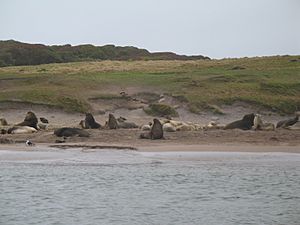
New Zealand sea lions are thought to be the most threatened sea lion in the world. Their status is mostly affected by the main group living in the Auckland Islands. This group decreased by about 50% between 2000 and 2015. In 2013, the number of pups born on the Auckland Islands increased to 1931. This was up from 1684 in 2012. (Even dead pups are counted to help estimate the number of breeding females). The 2013 number was the highest in five years.
The group on Campbell Island seems to be slowly growing. About 30% of all sea lion births happen there. The sea lion groups on Otago and Stewart Island are small right now, but they are increasing. The total number of sea lions went down from about 15,000 in the mid-1990s to 9,000 in 2008.
In 2010, the Department of Conservation changed the New Zealand Threat Classification System ranking. They moved it from Nationally Endangered to Nationally Critical. This means they are in even more danger. The Department of Conservation thinks that the Auckland Islands sea lions, which are almost 80% of the total, could almost disappear by 2035. However, the New Zealand Ministry for Primary Industries believes this prediction is not very reliable.
In 2015, the International Union for Conservation of Nature (IUCN) changed the species' classification to "Endangered." This was because of their small total population size. Also, there are only a few breeding groups, and the Auckland Islands population is expected to keep shrinking.
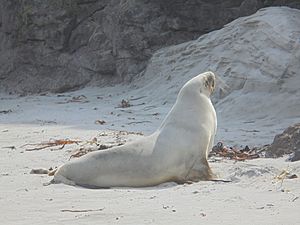
What Threats Do They Face?
Hunting in the Past
Between the 13th and 19th centuries, people hunted sea lions for food and for their fur. This greatly reduced the number of New Zealand sea lions and where they lived. In 1893, hunting for both New Zealand sea lions and New Zealand fur seals became illegal in New Zealand.
Caught in Fishing Nets
In the 1990s, more squid fishing happened around the Auckland Islands. Sadly, many sea lions were accidentally caught and drowned in the squid fishing nets. This is called bycatch. The government sets a limit each year for how many sea lions can be accidentally caught. If they think this limit will be passed, the fishing can be stopped. The last time this limit was passed was in 2000.
In 2014, observers were on 84% of the fishing boats. They reported that two sea lions were caught in the squid fishery that year. In 2013, young sea lions slipped through a special grid in the net. This grid is designed to let squid pass through but hold back adult sea lions. One adult female was also caught by accident that year.
In August 2013, 21 male sea lions were caught by a different fishing fleet. This happened more than 100 kilometers (62 miles) off the Campbell Islands. Four of them were released alive. The government asked these boats to try using special devices to help sea lions escape.
Sea Lion Exclusion Devices (SLEDs)
In 2001, a device called the sea lion exclusion device (SLED) was introduced. It was used in the Auckland Island squid fishery to help reduce the number of sea lions caught by accident. Since 2007, all boats in this fishery have used SLEDs. Some scientists are still not sure if sea lions survive after escaping a SLED. However, the Ministry for Primary Industries believes that fishing deaths have a very small effect on the sea lion population. They think a sea lion has an 85% chance of escaping a SLED. They also believe there's a 97% chance of surviving after escaping.
Not Enough Food
Not having enough food is a big reason why populations of pinnipeds (like seals and sea lions) change. The Auckland Islands sea lion population has shown many signs of not having enough food. This happened during their recent decline. For example, mothers were not in good condition. They also started having babies later in life. Some years had very few pups born. Many pups did not survive. And their diet changed over time. In 2015, starvation was thought to be the cause of death for 62% of pups studied at Campbell Island. About 58% of all pups born there died in their first month of life.
Diseases
The number of pups born on Auckland Island changes a lot each year. But for some years, the numbers went down after a disease outbreak in 1998. This disease was caused by a type of bacteria called Campylobacter. It killed about 53% of newborn pups and 20% of adult females. In 2002, another bacteria called Klebsiella pneumoniae caused a disease. It killed 32% of pups. In 2003, it killed another 21% of pups. Since 2002, K. pneumoniae has caused many deaths in sea lion pups on Enderby Island. Infected pups can get meningitis and a serious infection called sepsis. In 2014, the Conservation Minister Nick Smith said that 300 pups had died that summer from a disease that was not yet identified.
Threats on the Mainland
The population of sea lions on the mainland is expected to reach 1000 animals by 2044. This could lead to new challenges. These include needing special protected areas in the ocean, setting limits on local fishing, and managing the number of sea lions.
See also
 In Spanish: León marino de Nueva Zelanda para niños
In Spanish: León marino de Nueva Zelanda para niños



